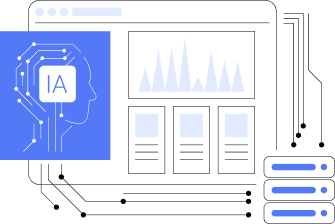Ethics & Policy
10 Steps for Safe AI Deployment
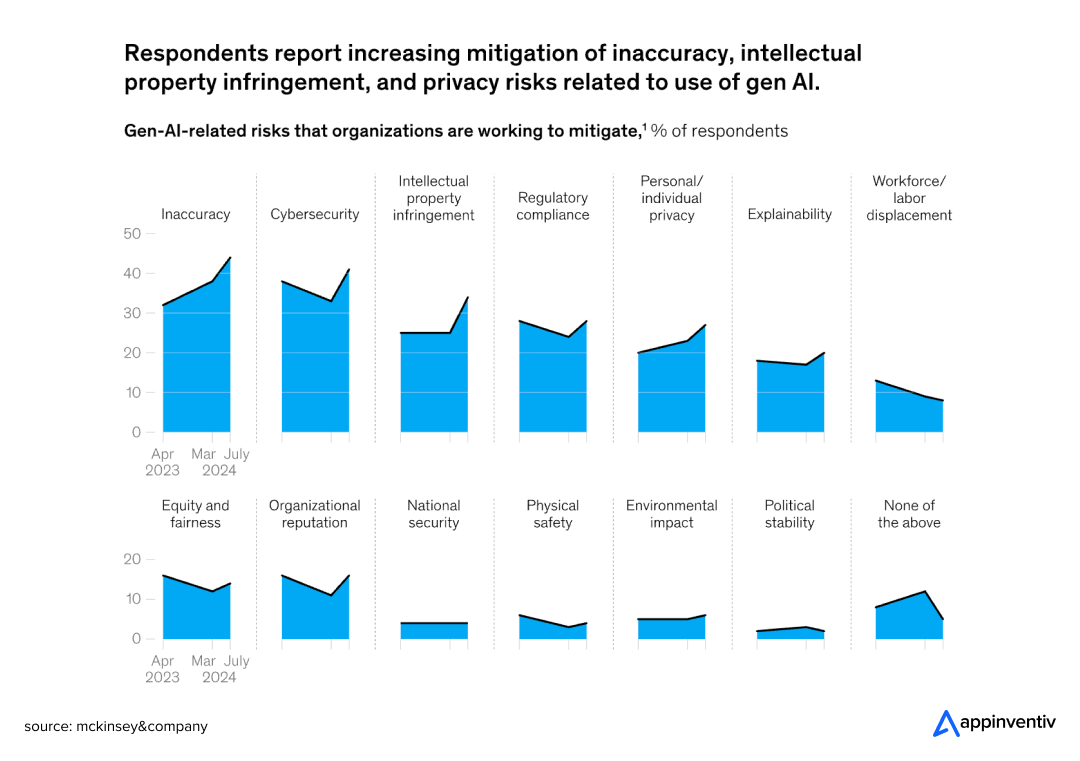
- Generative AI is a double-edged sword. It offers immense opportunities for growth and innovation. However, it also carries risks related to bias, security, and compliance
- Proactive governance is not optional. A responsible Generative AI deployment checklist helps leaders minimize risks and maximize trust.
- The checklist for Generative AI compliance assessment covers everything, including data integrity, ethical alignment, human oversight, continuous monitoring, and more.
- The ROI of responsible AI goes beyond compliance. This leads to increased consumer trust, reduced long-term costs, and a strong competitive advantage.
- Partner with AI experts like Appinventiv to turn Gen AI principles into a practical, actionable framework for your business.
The AI revolution is here, with generative models like GPT and DALL·E unlocking immense potential. In the blink of an eye, generative AI has moved from the realm of science fiction to a staple of the modern workplace. It’s no longer a question of if you’ll use it, but how and, more importantly, how well.
The potential is astounding: Statista’s latest research reveals that the generative AI market is projected to reach from $66.89 billion in 2025 to $442.07 billion by 2031. The race is on, and companies are deploying these powerful models to perform nearly every operational process. Businesses use Gen AI to create content, automate workflows, write code, analyze complex data, redefine customer experiences, and so on.
But as with any revolution, there’s a flip side. The same technology that can boost creativity can also introduce a host of unforeseen risks, from perpetuating biases to leaking sensitive data and creating “hallucinations” that are factually incorrect. The stake is truly high. According to McKinsey’s latest research, 44% of organizations have already experienced negative consequences from not evaluating generative AI risks.
As AI systems become integral to decision-making, the question arises: Are we ready to manage these gen AI risks effectively?
This is where the responsible AI checklist comes in. This blog covers the 10 critical AI governance questions every business leader must ask before deploying generative AI. These questions will help mitigate risks, build trust, and ensure that your AI deployment efforts align with legal, ethical, and operational standards.
AI Risks Are Real. Act Now!
Contact us for a comprehensive AI risk assessment to maximize AI benefits and minimize risks.
Why Businesses Across Industries Prioritize Responsible AI Deployment
Before we dive into the questions, let’s be clear: responsible AI isn’t an afterthought; it’s a core component of your business strategy. Without a responsible governance framework, you may risk technical failures, your brand image, your finances, and your very relationship with your customers. Here is more on why it’s essential for leaders to prioritize responsible AI practices:

Mitigating Risk
Responsible AI is not about slowing down innovation. It’s about accelerating it safely. Without following Generative AI governance best practices, AI projects can lead to serious legal, financial, and reputational consequences.
Companies that rush into AI deployment often spend months cleaning up preventable messes. On the other hand, companies that invest time upfront in responsible AI practices in their AI systems actually work better and cause fewer operational headaches down the road.
Enhancing Operational Efficiency
By implementing responsible AI frameworks, businesses can make sure their AI systems are secure and aligned with business goals. This approach helps them avoid costly mistakes and ensures the reliability of AI-driven processes.
The operational benefits are real and measurable. Teams stop worrying about whether AI systems will create embarrassing incidents, customers develop trust in automated decisions, and leadership can focus on innovation instead of crisis management.
Staying Compliant
The EU AI Act is now fully implemented, with fines reaching up to 7% of global revenue for serious violations. In the US, agencies like the EEOC are actively investigating AI bias cases. One major financial institution recently paid $2.5 million for discriminatory lending algorithms. Another healthcare company had to pull its diagnostic AI after privacy violations.
These are not isolated incidents. They are predictable outcomes when companies build and deploy AI models without a proper Generative AI impact assessment.
Upholding Ethical Standards
Beyond legal compliance, it is essential that AI systems operate in accordance with principles of fairness, transparency, and accountability. These ethical considerations are necessary to protect both businesses and their customers’ sensitive data.
Companies demonstrating responsible AI practices report higher customer trust scores and significantly better customer lifetime value. B2B procurement teams now evaluate Generative AI governance as standard vendor selection criteria.
Major business giants, including Microsoft, Google, and NIST, are already weighing in on Generative AI risk management and responsible AI practices. Now it’s your turn. With that said, here is a Generative AI deployment checklist for CTOs you must be aware of:
The Responsible AI Checklist: 10 Generative AI Governance Questions Leaders Must Ask
So, are you ready to deploy Generative AI? That’s great. But before you do, you must be aware of the Pre-deployment AI validation questions to make sure you’re building on a solid foundation, not quicksand. Here is a series of Generative AI risk assessment questions to ask your teams before, during, and after deploying a generative AI solution.
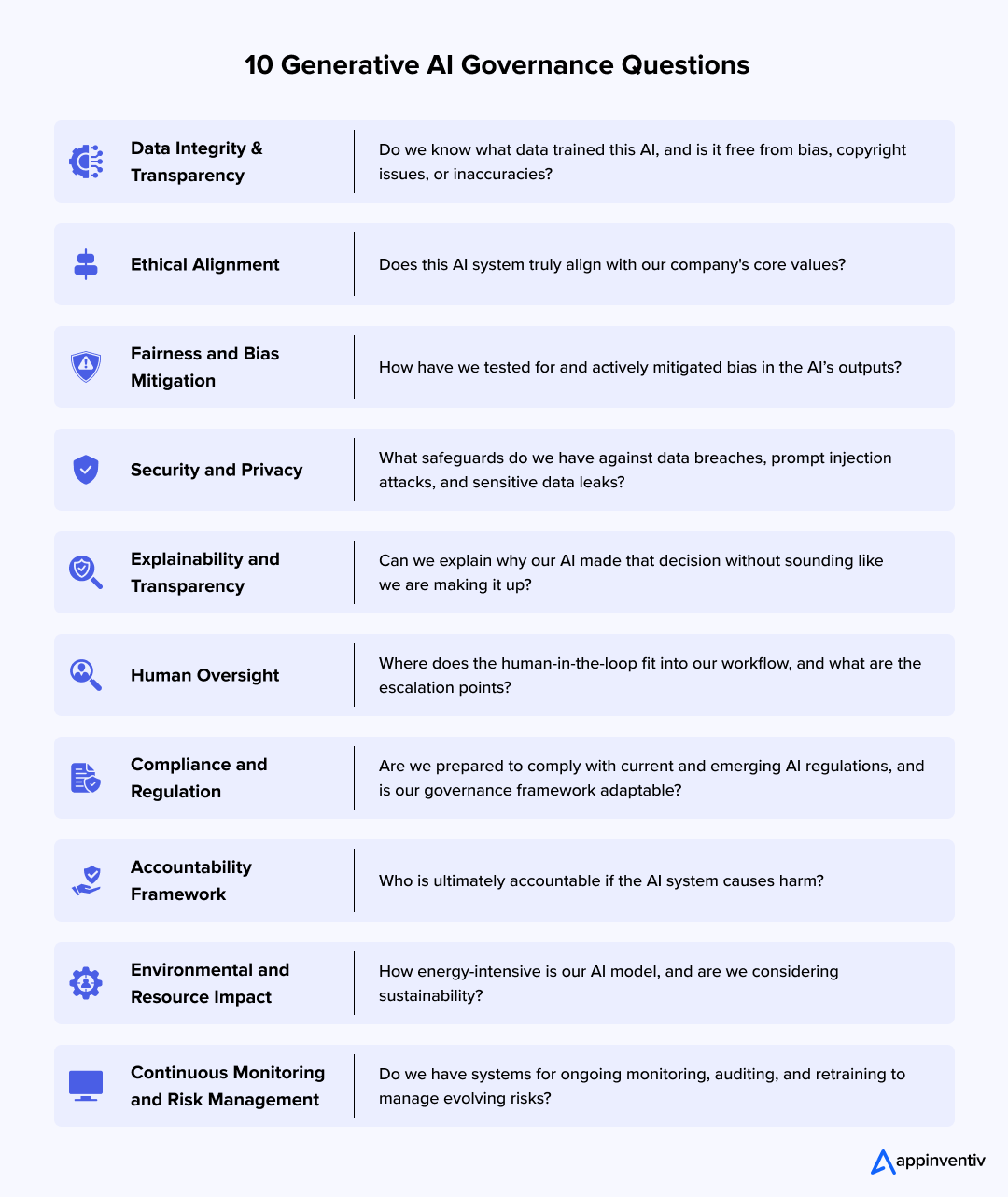
1. Data Integrity and Transparency
The Question: Do we know what data trained this AI, and is it free from bias, copyright issues, or inaccuracies?
Why It Matters: An AI model is only as good as its data. Most foundational models learn from a massive, and often messy, collection of data scraped from the internet. This can lead to the model making up facts, which we call “hallucinations,” or accidentally copying copyrighted material. It’s a huge legal and brand risk.
Best Practice: Don’t just take the vendor’s word for it. Demand thorough documentation of the training data. For any internal data you use, set clear sourcing policies and perform a detailed audit to check for quality and compliance.
2. Ethical Alignment
The Question: Does this AI system truly align with our company’s core values?
Why It Matters: This goes way beyond checking legal boxes. This question gets to the heart of your brand identity. Your AI doesn’t just process data; it becomes the digital face of your values. Every decision it makes, every recommendation it offers, represents your company.
Let’s say your company values fairness and equality. If your new AI hiring tool, through no fault of its own, starts to favor male candidates because of an undetected bias, that’s a direct contradiction of your values. It’s a fast track to a PR crisis and a loss of employee morale.
Best Practice: Create an internal AI ethics charter. Form a cross-functional ethics board with representatives from legal, marketing, and product teams to review and approve AI projects.
At Appinventiv, we have seen this principle in action. When developing JobGet, an AI-driven job search platform, we ensure AI matching algorithms promote equal opportunity for everyone, which aligns with our clients’ diversity commitments. This job search platform ensures that no candidate is unfairly disadvantaged by bias, creating a transparent and trustworthy platform for job seekers and employers alike.
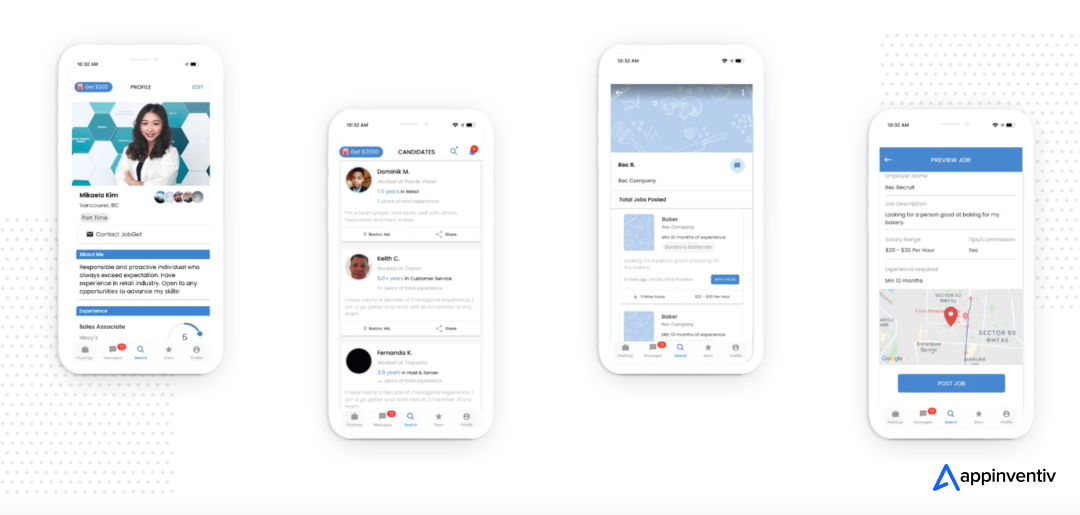
3. Fairness and Bias Mitigation
The Question: How have we tested for and actively mitigated bias in the AI’s outputs?
Why It Matters: Bias in AI is not some abstract academic concern; it’s a business-killing reality that has already destroyed careers and companies. You might be aware of the facial recognition systems that couldn’t recognize darker skin tones and loan algorithms that treated identical applications differently based on zip codes that correlated with race.
Here’s what keeps business leaders awake at night: your AI might be discriminating right now, and you’d never know unless you specifically looked for it. These systems are brilliant at finding patterns, including patterns you never intended them to learn.
Best Practice: Test everything. Use datasets that actually represent the real world, not just convenient samples. Regularly audit AI models’ performance across different groups and discover uncomfortable truths about their systems.
Also Read: Benefits of Facial Recognition Software Development
4. Security and Privacy
The Question: What safeguards do we have against data breaches, prompt injection attacks, and sensitive data leaks?
Why It Matters: Generative AI creates new security weak points. An employee might paste confidential customer information into a public model to get a quick summary. That data is then out in the wild and misused by cyber fraudsters. As IBM’s 2024 report showed, the cost of a data breach jumped to $4.88 million in 2024 from $4.45 million in 2023, a 10% spike from the previous year. These are real vulnerabilities that require a proactive defense.
Best Practice: Implement strict data minimization policies and use encryption. Train employees on the risks and set up secure, private environments for any sensitive work.
5. Explainability and Transparency
The Question: Can we explain why our AI made that decision without sounding like we are making it up?
Why It Matters: Many advanced AI models operate as “black boxes”; they give you answers but refuse to show their work. That might sound impressive in a science fiction movie, but it’s a nightmare for real business applications.
Imagine explaining to an angry customer why your “black box” algorithm rejected their loan application. Good luck with that conversation. In high-stakes situations like medical diagnosis or financial decisions, “because the AI said so” isn’t going to cut it with regulators, customers, or your own conscience.
Best Practice: Use Explainable AI (XAI) tools to visualize and interpret the model’s logic. Ensure a clear audit trail for every output and decision the AI makes.
6. Human Oversight
The Question: Where does the human-in-the-loop fit into our workflow, and what are the escalation points?
Why It Matters: While AI can automate tasks, human judgment remains essential for ensuring accuracy and ethical behavior. Automation bias can lead people to blindly trust an AI’s output without critical review. The risk is especially high in creative or analytical fields where the AI is seen as a “co-pilot.”
Best Practice: Define specific moments when human expertise matters most. Train your staff to question AI outputs, not just approve them. And they create clear escalation paths for when things get complicated or controversial.
7. Compliance and Regulation
The Question: Are we prepared to comply with current and emerging AI regulations, and is our governance framework adaptable?
Why It Matters: The legal landscape for AI is a moving target. What’s perfectly legal today might trigger massive fines tomorrow. A rigid governance framework will quickly become outdated. Leaders need to build a system that can evolve with new laws, whether they are focused on data privacy, intellectual property, or algorithmic transparency.
For example, the EU AI Act was passed by the European Parliament in March 2024, introduces strict requirements for high-risk AI systems and has different timelines for various obligations, highlighting the need for a flexible governance model.
Best Practice: Assign someone smart to watch the regulatory horizon full-time. Conduct regular compliance audits and design your framework with flexibility in mind.
8. Accountability Framework
The Question: Who is ultimately accountable if the AI system causes harm?
Why It Matters: This is a question of legal and ethical ownership. If an AI system makes a critical error that harms a customer or leads to a business loss, who is responsible? Is it the developer, the product manager, the C-suite, or the model provider? Without a clear answer, you create a dangerous vacuum of responsibility.
Best Practice: Define and assign clear ownership roles for every AI system. Create a clear accountability framework that outlines who is responsible for the AI’s performance, maintenance, and impact.
9. Environmental and Resource Impact
The Question: How energy-intensive is our AI model, and are we considering sustainability?
Why It Matters: Training and running large AI models require massive amounts of power. For any company committed to ESG (Environmental, Social, and Governance) goals, ignoring this isn’t an option. It’s a reputational and financial risk that’s only going to grow.
Best Practice: Prioritize model optimization and use energy-efficient hardware. Consider green AI solutions and choose cloud models that run with sustainability in mind.
10. Continuous Monitoring and Risk Management
The Question: Do we have systems for ongoing monitoring, auditing, and retraining to manage evolving risks?
Why It Matters: The risks associated with AI don’t end at deployment. A model’s performance can “drift” over time as real-world data changes or new vulnerabilities can emerge. Without a system for Generative AI risk management and continuous monitoring, your AI system can become a liability without you even realizing it.
Best Practice: Implement AI lifecycle governance. Use automated tools to monitor for model drift, detect anomalies, and trigger alerts. Establish a schedule for regular retraining and auditing to ensure the model remains accurate and fair.
Have any other questions in mind? Worry not. We are here to address that and help you ensure responsible AI deployment. Contact us for a detailed AI assessment and roadmap creation.
Common Generative AI Compliance Pitfalls and How to Avoid Them
Now that you know the critical questions to ask before deploying AI, you are already ahead of most organizations. But even armed with the right questions, it’s still surprisingly easy to overlook the risks hiding behind the benefits. Many organizations dive in without a clear understanding of the regulatory minefield they are entering. Here are some of the most common generative AI compliance pitfalls you may encounter and practical advice on how to steer clear of them.
Pitfall 1: Ignoring Data Provenance and Bias
A major mistake is assuming your AI model is a neutral tool. In reality, it’s a reflection of the data it was trained on, and that data is often biased and full of copyright issues. This can lead to your AI system making unfair decisions or producing content that infringes on someone’s intellectual property. This is a critical area of Generative AI legal risks.
- How to avoid it: Before you even think about deployment, perform a thorough Generative AI risk assessment. Use a Generative AI governance framework to vet the training data.
Pitfall 2: Lack of a Clear Accountability Framework
When an AI system makes a costly mistake, who takes the blame? In many companies, the answer is not clear. Without a defined responsible AI deployment framework, you end up with a vacuum of responsibility, which can lead to finger-pointing and chaos during a crisis.
- How to avoid it: Clearly define who is responsible for the AI’s performance, maintenance, and impact from the start. An executive guide to AI governance should include a section on assigning clear ownership for every stage of the AI lifecycle.
Pitfall 3: Failing to Keep Up with Evolving Regulations
The regulatory landscape for AI is changing incredibly fast. What was permissible last year might land you in legal trouble today. Companies that operate with a static compliance mindset are setting themselves up for fines and legal action.
- How to avoid it: Treat your compliance efforts as an ongoing process, not a one-time project. Implement robust Generative AI compliance protocols and conduct a regular AI governance audit to ensure you are staying ahead of new laws. An AI ethics checklist for leaders should always include a review of the latest regulations.
Pitfall 4: Neglecting Human Oversight and Transparency
It’s tempting to let an AI handle everything, but this can lead to what’s known as “automation bias,” where employees blindly trust the AI’s output without question. The lack of a human-in-the-loop can be a major violation of Generative AI ethics for leaders and create a huge liability.
- How to avoid it: Ensure your Generative AI impact assessment includes a plan for human oversight. You need to understand how to explain the AI’s decisions, especially for high-stakes applications. This is all part of mitigating LLM risks in enterprises.
Don’t Let AI Risks Catch You Off Guard
Let our AI experts conduct a comprehensive AI governance audit to ensure your generative AI model is secure and compliant.
How to Embed Responsible AI Throughout Generative AI Development
You can’t just check the “responsible AI” box once and call it done. Smart companies weave these practices into every stage of their AI projects, from the first brainstorming session to daily operations. Here is how they do it right from start to end:
- Planning Stage: Before anyone touches code, figure out what could go wrong. Identify potential risks, understand the needs of different stakeholders, and detect ethical landmines early. It’s much easier to change direction when you’re still on paper than when you have a half-built system.
- Building Stage: Your developers should be asking “Is this fair?” just as often as “Does this work?” Build fairness testing into your regular coding routine. Test for bias like you’d test for bugs. Make security and privacy part of your standard development checklist, not something you bolt on later.
- Launch Stage: Deployment day isn’t when you stop paying attention; it’s when you start paying closer attention. Set up monitoring systems that actually work. Create audit schedules you’ll stick to. Document your decisions so you can explain them later when someone inevitably asks, “Why did you do it that way?”
- Daily Operations: AI systems change over time, whether you want them to or not. Data shifts, regulations updates, and business needs evolve. Thus, you must schedule regular check-ups for your AI just like you would for any critical business system. Update policies when laws change. Retrain models when performance drifts.
The Lucrative ROI of Responsible AI Adoption
Adhering to the Generative AI compliance checklist is not an extra step. The return on investment for a proactive, responsible AI strategy is immense. You’ll reduce long-term costs from lawsuits and fines, and by building trust, you’ll increase customer adoption and loyalty. In the short term, the long-term benefits of adopting responsible AI practices far outweigh the initial costs. Here’s how:
- Risk Reduction: Prevent costly legal battles and fines from compliance failures or misuse of data.
- Brand Loyalty: Companies that build trust by adhering to ethical AI standards enjoy higher customer retention.
- Operational Efficiency: AI systems aligned with business goals and ethical standards tend to be more reliable, secure, and cost-efficient.
- Competitive Advantage: Data-driven leaders leveraging responsible AI are better positioned to attract customers, investors, and talent in an increasingly ethical marketplace.
The Appinventiv Approach to Responsible AI: How We Turn Strategy Into Reality
At Appinventiv, we believe that innovation and responsibility go hand in hand. We stand by you not just to elevate your AI digital transformation efforts, but we stand by you at every step to do it right.
We help our clients turn this responsible AI checklist from a list of daunting questions into an actionable, seamless process. Our skilled team of 1600+ tech experts answers all the AI governance questions and follows the best practices to embed them in your AI projects. Our Gen AI services are designed to support you at every stage:
- AI Strategy & Consulting: Our Generative AI consulting services help you plan the right roadmap. We work with you to define your AI objectives, identify potential risks, and build a roadmap for responsible deployment.
- Secure AI Development: Our Generative AI development services are designed on a “privacy-by-design” principle, ensuring your models are secure and your data is protected from day one.
- Generative AI Governance Frameworks: We help you design and implement custom AI data governance frameworks tailored to your specific business needs. This approach helps ensure compliance and accountability.
- Lifecycle Support: AI systems aren’t like traditional software that you can deploy and forget about. They need regular check-ups, performance reviews, and updates to stay trustworthy and effective over time. At Appinventiv, we monitor, audit, and update your AI systems for lasting performance and trust.
How We Helped a Global Retailer Implement Responsible AI
We worked with a leading retailer to develop an AI-powered recommendation engine. By embedding responsible AI principles from the beginning, we ensured the model was bias-free, secure, and explainable, thus enhancing customer trust and compliance with privacy regulations.
Ready to build your responsible AI framework? Contact our AI experts today and lead with confidence.
FAQs
Q. How is governing generative AI different from traditional software?
A. Traditional software follows predictable, deterministic rules, but generative AI is different. Its outputs can be unpredictable, creating unique challenges around hallucinations, bias, and copyright. The “black box” nature of these large models means you have to focus more on auditing their outputs than just their code.
Q. What are the most common risks overlooked when deploying generative AI?
A. Many leaders overlook intellectual property infringement, since models can accidentally replicate copyrighted material. Prompt injection attacks are also often missed, as they can manipulate the model’s behavior. Lastly, the significant environmental impact and long-term costs of training and running these large models are frequently ignored.
Q. How do we measure the effectiveness of our responsible AI practices?
A. You can measure effectiveness both quantitatively and qualitatively. Track the number of bias incidents you have detected and fixed. Monitor the time it takes to resolve security vulnerabilities. You can also get qualitative feedback by conducting surveys to gauge stakeholder trust in your AI systems.
Q. What is a responsible AI checklist, and why do we need one?
A. A responsible AI checklist helps companies assess the risks and governance efficiently. The checklist is essential for deploying AI systems safely, ethically, and legally.
Q. What are the six core principles of Generative AI impact assessment?
A. Generative AI deployment checklist aligns with these six core principles:
- Fairness
- Reliability & Safety
- Privacy & Security
- Inclusiveness
- Transparency
- Accountability
Ethics & Policy
Tech leaders in financial services say responsible AI is necessary to unlock GenAI value

Good morning. CFOs are increasingly responsible for aligning AI investments with business goals, measuring ROI, and ensuring ethical adoption. But is responsible AI an overlooked value creator?
Scott Zoldi, chief analytics officer at FICO and author of more than 35 patents in responsible AI methods, found that many customers he’s spoken to lacked a clear concept of responsible AI—aligning AI ethically with an organizational purpose—prompting an in-depth look at how tech leaders are managing it.
According to a new FICO report released this morning, responsible AI standards are considered essential innovation enablers by senior technology and AI leaders at financial services firms. More than half (56%) named responsible AI a leading contributor to ROI, compared to 40% who credited generative AI for bottom-line improvements.
The report, based on a global survey of 254 financial services technology leaders, explores the dynamic between chief AI/analytics officers—who focus on AI strategy, governance, and ethics—and CTOs/CIOs, who manage core technology operations and alignment with company objectives.
Zoldi explained that, while generative AI is valuable, tech leaders see the most critical problems and ROI gains arising from responsible AI and true synchronization of AI investments with business strategy—a gap that still exists in most firms. Only 5% of respondents reported strong alignment between AI initiatives and business goals, leaving 95% lagging in this area, according to the findings.
In addition, 72% of chief AI officers and chief analytics officers cite insufficient collaboration between business and IT as a major barrier to company alignment. Departments often work from different metrics, assumptions, and roadmaps.
This difficulty is compounded by a widespread lack of AI literacy. More than 65% said weak AI literacy inhibits scaling. Meanwhile, CIOs and CTOs report that only 12% of organizations have fully integrated AI operational standards.
In the FICO report, State Street’s Barbara Widholm notes, “Tech-led solutions lack strategic nuance, while AI-led initiatives can miss infrastructure constraints. Cross-functional alignment is critical.”
Chief AI officers are challenged to keep up with the rapid evolution of AI. Mastercard’s chief AI and data officer, Greg Ulrich, recently told Fortune that last year was “early innings,” focused on education and experimentation, but that the role is shifting from architect to operator: “We’ve moved from exploration to execution.”
Across the board, FICO found that about 75% of tech leaders surveyed believe stronger collaboration between business and IT leaders, together with a shared AI platform, could drive ROI gains of 50% or more. Zoldi highlighted the problem of fragmentation: “A bank in Australia I visited had 23 different AI platforms.”
When asked about innovation enablers, 83% of respondents rated cross-departmental collaboration as “very important” or “critical”—signaling that alignment is now foundational.
The report also stresses the importance of human-AI interaction: “Mature organizations will find the right marriage between the AI and the human,” Zoldi said. And that involves human understanding for where to ”best place AI in that loop,” he said.
Sheryl Estrada
sheryl.estrada@fortune.com
Leaderboard
Brian Robins was appointed CFO of Snowflake (NYSE: SNOW), an AI Data Cloud company, effective Sept. 22. Snowflake also announced that Mike Scarpelli is retiring as CFO. Scarpelli will stay a Snowflake employee for a transition period. Robins has served as CFO of GitLab Inc., a technology company, since October 2020. Before that, he was CFO of Sisense, Cylance, AlienVault, and Verisign.
Big Deal
August marked the S&P 500’s fourth consecutive month of gains, with E*TRADE clients net buyers in eight out of 11 sectors, Chris Larkin, managing director of trading and investing, said in a statement. “But some of that buying was contrarian and possibly defensive,” Larkin noted. “Clients rotated most into utilities, a defensive sector that was actually the S&P 500’s weakest performer last month. Another traditionally defensive sector, consumer staples, received the third-most net buying.” By contrast, clients were net sellers in three sectors—industrials, communication services, and financials—which have been among the S&P 500’s stronger performers so far this year.
“Given September’s history as the weakest month of the year for stocks, it’s possible that some investors booked profits from recent winners while increasing positions in defensive areas of their portfolios,” Larkin added.
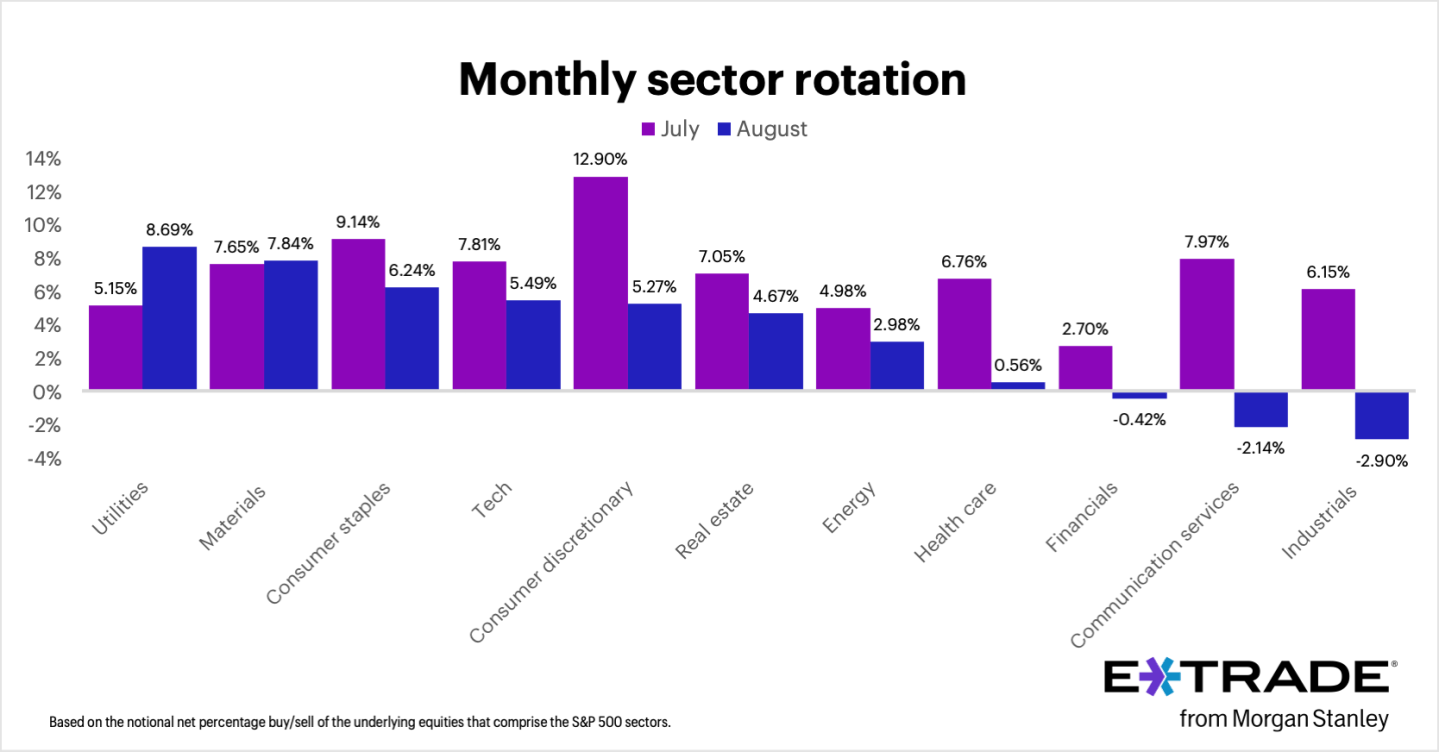
Going deeper
“Warren Buffett’s $57 billion face-plant: Kraft Heinz breaks up a decade after his megamerger soured” is a Fortune report by Eva Roytburg.
From the report: “Kraft Heinz, the packaged-food giant created in 2015 by Warren Buffett and Brazilian private equity firm 3G Capital, is officially breaking up. The Tuesday announcement ends one of Buffett’s highest-profile bets—and one of his most painful—as the merger that once promised efficiency and dominance instead wiped out roughly $57 billion, or 60%, in market value. Shares slid 7% after the announcement, and Berkshire Hathaway still owns a 27.5% stake.” You can read the complete report here.
Overheard
“Effective change management is the linchpin of enterprise-wide AI implementation, yet it’s often underestimated. I learned this first-hand in my early days as CEO at Sanofi.”
—Paul Hudson, CEO of global healthcare company Sanofi since September 2019, writes in a Fortune opinion piece. Previously, Hudson was CEO of Novartis Pharmaceuticals from 2016 to 2019.
Ethics & Policy
Humans at Core: Navigating AI Ethics and Leadership

Hyderabad recently hosted a vital dialogue on ‘Human at Core: Conversations on AI, Ethics and Future,’ co-organized by IILM University and The Dr Pritam Singh Foundation at Tech Mahindra, Cyberabad. Gathering prominent figures from academia, government, and industry, the event delved into the ethical imperatives of AI and human-centric leadership in a tech-driven future.
The event commenced with Sri Gaddam Prasad Kumar advocating for technology as a servant to humanity, followed by a keynote from Sri Padmanabhaiah Kantipudi, who addressed the friction between rapid technological growth and ethical governance. Two pivotal panels explored the crossroads of AI’s progress versus principle and leadership’s critical role in AI development.
Key insights emerged around empathy and foresight in AI’s evolution, as leaders like Manoj Jha and Rajesh Dhuddu emphasized. Dr. Ravi Kumar Jain highlighted the collective responsibility to steer innovation wisely, aligning technological advancement with human values. The event reinforced the importance of cross-sector collaboration to ensure technology enhances equity and dignity globally.
Ethics & Policy
IILM University and The Dr Pritam Singh Foundation Host Round Table Conference on “Human at Core” Exploring AI, Ethics, and the Future

Hyderabad (Telangana) [India], September 4: IILM University, in collaboration with The Dr Pritam Singh Foundation, hosted a high-level round table discussion on the theme “Human at Core: Conversations on AI, Ethics and Future” at Tech Mahindra, Cyberabad, on 29th August 2025. The event brought together distinguished leaders from academia, government, and industry to engage in a timely and thought-provoking dialogue on the ethical imperatives of artificial intelligence and the crucial role of human-centric leadership in shaping a responsible technological future. The proceedings began with an opening address by Sri Gaddam Prasad Kumar, Speaker, Telangana Legislative Assembly, who emphasised the need to ensure that technology remains a tool in the service of humanity. This was followed by a keynote address delivered by Sri Padmanabhaiah Kantipudi, IAS (Retd.), Chairman of the Administrative Staff College of India (ASCI), who highlighted the growing tension between technological acceleration and ethical oversight.
The event featured two significant panel discussions, each addressing the complex intersections between technology, ethics, and leadership. The first panel, moderated by Mamata Vegunta, Executive Director and Head of HR at DBS Tech India, examined the question, “AI’s Crossroads: The Choice Between Progress and Principle.” The discussion reflected on the critical junctures at which leaders must make choices that balance innovation with responsibility. Panellists, including Deepak Gowda of the Union Learning Academy, Dr. Deepak Kumar of IDRBT, Srini Vudumula of Novelis Consulting, and Gaurav Maheshwari of Signode India Limited, shared their insights on the pressing need for robust ethical frameworks that evolve alongside AI.
The second panel, moderated by Vinay Agrawal, Global Head of Business HR at Tech Mahindra, focused on the theme “Human-Centred AI: Why Leadership Matters More Than Ever.” This session brought to light the growing expectation of leaders to act not just as enablers of technological progress, but as custodians of its impact. Panellists Manoj Jha from Makeen Energy, Dr Anadi Pande from Mahindra University, Rajesh Dhuddu of PwC, and Kiranmai Pendyala, investor and former UWH Chairperson, collectively underlined the importance of empathy, accountability, and foresight in guiding AI development.
Speaking at the event, Dr Ravi Kumar Jain, Director, School of Management – IILM University Gurugram, remarked, “We are at a defining moment in human history, where the question is not merely about how fast we can innovate, but how wisely we choose to do so. At IILM, we believe in nurturing leaders who are not only competent but also conscious of their responsibilities to society.” His sentiments were echoed by Prof Harivansh Chaturvedi, Director General at IILM Lodhi Road, who affirmed the university’s continued commitment to promoting responsible leadership through dialogue, collaboration, and critical inquiry. Across both panels, there was a shared recognition that ethical leadership must keep pace with the rapid transformations driven by AI, and that collaborative efforts across sectors will be essential to ensure that innovation serves the broader goals of equity, dignity, and humanity.
The discussions concluded with a renewed call to action for academic institutions, industry leaders, and policymakers to work together in shaping a future where technology empowers without eroding core human values. In doing so, the event reaffirmed the central message behind its theme that in an increasingly digital world, it is important now more than ever to keep it human at the core.
(Disclaimer: The above press release comes to you under an arrangement with PNN and PTI takes no editorial responsibility for the same.). PTI PWR
(This content is sourced from a syndicated feed and is published as received. The Tribune assumes no responsibility or liability for its accuracy, completeness, or content.)
-

 Business6 days ago
Business6 days agoThe Guardian view on Trump and the Fed: independence is no substitute for accountability | Editorial
-
Tools & Platforms3 weeks ago
Building Trust in Military AI Starts with Opening the Black Box – War on the Rocks
-

 Ethics & Policy1 month ago
Ethics & Policy1 month agoSDAIA Supports Saudi Arabia’s Leadership in Shaping Global AI Ethics, Policy, and Research – وكالة الأنباء السعودية
-

 Events & Conferences4 months ago
Events & Conferences4 months agoJourney to 1000 models: Scaling Instagram’s recommendation system
-

 Jobs & Careers2 months ago
Jobs & Careers2 months agoMumbai-based Perplexity Alternative Has 60k+ Users Without Funding
-

 Education2 months ago
Education2 months agoVEX Robotics launches AI-powered classroom robotics system
-

 Funding & Business2 months ago
Funding & Business2 months agoKayak and Expedia race to build AI travel agents that turn social posts into itineraries
-

 Podcasts & Talks2 months ago
Podcasts & Talks2 months agoHappy 4th of July! 🎆 Made with Veo 3 in Gemini
-

 Podcasts & Talks2 months ago
Podcasts & Talks2 months agoOpenAI 🤝 @teamganassi
-

 Education2 months ago
Education2 months agoMacron says UK and France have duty to tackle illegal migration ‘with humanity, solidarity and firmness’ – UK politics live | Politics


